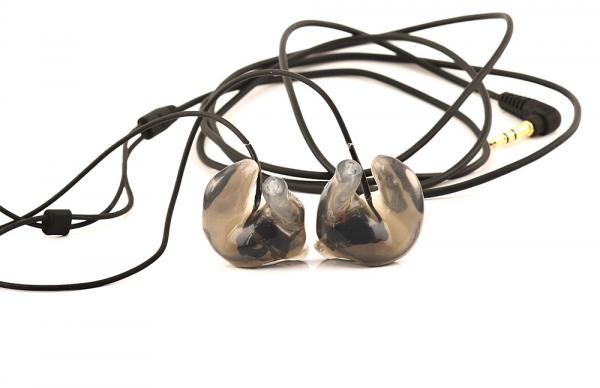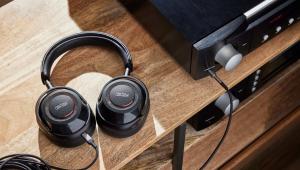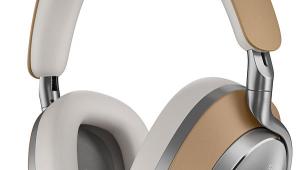Review: Altec Lansing/ACS Custom In-Ear Monitors

When we last looked at Altec Lansing's headphone offerings, we checked out their affordable universal-fit balanced-armature IEM, the Muzx Ultra. But that's not all there is to the longstanding brand's headphone offerings. Late last year, the company went all-in with a premium headphone line, and we've had a chance to spend some time with them over the last few months.
The A series is a custom-fit solution, also based on balanced-armature drivers, though this time around Altec decided that rather than develop a new product from scratch, they would take advantage of a partnership with an established industry leader, in this case UK-based ACS. The Altec Lansing A1 ($499.95), A2 (799.95), and A3 ($999.95) - the single, dual, and triple driver models in the lineup - are custom-voiced versions of ACS's existing T3, T2, and T1 models (yes, it's a little confusing - ACS doesn't use the number to signify number of drivers, so the T1 is the triple driver, T2 the double, and T3 the single), all longstanding favorites in the European stage monitor market.
So does a repurposed pro audio product make sense for consumers - even the new breed of headphone audiophiles?
In terms of sheer functionally, a custom-fit solution gets about as close to the ideal on IEM performance as one might imagine - the fit and seal is close to perfect since the body of the IEM is taken from a cast of your own ear canals. Comfort , theoretically, is unparallelled, for the same reasons, though the custom fit can take a bit of getting used to. And for those with challenging pinnae or ear canals, custom may be the only route to a truly satisfying in-ear headphone audio experience. (I've got small ear canals and have always had difficulty with universal-fit in-ears, thus I'm squarely in the target market myself.)
Reviewing a custom unit is a challenge. It's impossible to gather opinions from multiple listeners, and the sorts of measurements we usually perform here at Sound+Vision are impossible, since they'd require a custom artificial earmold to match the subjective reviewer's. And that's a lot of goo (and expense) that'd only tell you a little about how the headphones sounded to me. So bear with me.
Setup
The fundamental aspect of getting a custom IEM is a visit to the audiologist to have earmolds taken. In various professional capacities I've had this done a few times now, and I'll tell you right now that it looks a lot worse than it is. A couple of cotton balls (strings attached so they won't get lost, so don't worry) get shoved (ever so gently) into your ears, where they sit at the big bend in your ear canal, protecting the delicate structures further upstream.
Once those are seated, your audiologist mixes up the contents of a couple of tubes of goo 'til the proper consistency is achieved. The process will look familiar to you if you'be ever mixed epoxy. That goes into a big syringe, and from there into your earholes. It's a little odd. You'll want photos.
Then you wait a few minutes. Various schools of thought hold that the subject should remain with mouth open, closed, or in motion, but whichever your provider settles on you'll experience five minutes or so of blissful sonic isolation as the stuff expands slightly and sets. Once removed, the molds go off to ACS, who fabricate your headphones. The process can take a few weeks.
Your phones arrive in a little Pelican watertight storage case (very handy for when you want to throw your pricey IEMs in your luggage); within that you'll find a leather zip pouch for daily use, along with a cleaning tool (you'll periodically have to clean ear gunk out of the canal tubes) and a sample-size water-based gel lubricant to ease fitting (you'll probably get used to wearing them quickly and won't need this in the long term).
While most manufacturers of pro custom-fit IEMs use hard acrylic casings, ACS fabricates the entire body of their monitors using soft silicone. While both materials have their advocates (Jerry Harvey has had great success with acrylics, while Westone have lately turned to a hybrid design, making the canal portion of their customs from silicone, while encasing the drivers in acrylic) ACS argues that the soft, flexible material warms quickly to body temperature, expanding slightly as it does for a near-perfect fit, and moving with the ear canal to ensure long-term comfort.
The downside of the silicone approach is that you don't get the choice of fancy finishes you might from JH Audio or Westone; rather, the ACS/Altec IEMs have a bit of an industrial/medical/hearing-aid look to them (the smoke finish Altec has chosen is pretty classy, however, so don't be dissuaded - you just can't get jeweled skulls and crossbones or the Yankees logo or whatever).
Another point to address: there's something of an arms race in driver count these days in the custom IEM market, with Ultimate Ears' UE 18 clocking in at six drivers per side and JH Audio's flagship JH16 Pro having recently raised the bar to a stunning 8 drivers per side (with the impressive miniaturization visible through the clear acrylic casings). You're generally looking at a three, or four-way crossover at maximum (even the JH16 uses a three-way crossover), so the multiple drivers are doubled up per frequency range. As with computer processor speeds and camera sensor pixel counts, the raw number doesn't tell the whole story. An 8-driver IEM and 3- or 4-way crossover can be well or poorly implemented, as can a 2-driver model with a 2-way crossover. So don't be put off by ACS's relatively minimal driver count; they've been doing this for quite a while. The true measure of these things is, of course, how they sound and feel in practice,
Perfomance
Turning first to comfort, the appeal of a custom 'phone is fit. And fit the A2s sure do: so long as your impressions are accurate, the ACS/Altec phones should give you as close to a perfect canalphone fit as possible.
And there's an art to fitting, of course.
As a result, I got to try both the A1 and A2 models. Initially, I received a pair of the single-driver A1. But that model is very tiny, with almost no material sitting in the bowl of your ear. Even though the fit of the A1 was basically spot-on (though perhaps not quite deep enough), my canals weren't up to the task of holding them in place on their own. I couldn't get a consistent seal in my left ear, so I went back to ACS to see if they could remedy the situation.
I ended up having a set of A2s made to replace the A1s; the larger casing (my second mold also went just a little further down the ear canal) gave me a secure fit. During the process, I was lucky enough to work with ACS USA's managing director, Craig Kasper, who did a great job with the fittings. (ACS maintains a network of audiologists nationwide, so you shouldn't have a problem finding someone good).
The second pair fit incredibly well; ACS supplies a tube of lubricating cream to ease insertion (yep, that sounds odd, I know), but I found it unnecessary. The deeper fit took a little getting used to - not painful, but it's a bit strange to shove something that much smaller than your elbow into your earhole. Anyway, once inserted, the 'phones take a minute or two to warm up to body temperature; once they do you won't notice that they're in. They're very comfortable.
Many of todays silicone and memory foam eartips do a wonderful job of isolation, but nothing compares to custom. Providing some 27 dB of isolation, slipping in the ACS IEMS really does cut you off from the world like nothing else will. Great for the subway - you can listen to pretty much whatever you want, while standing a little ways down-platform from a busking trombonist. Interference is minimal. I checked, and managed to enjoy the title track of Sandy Denny's The North Star Grassman and the Ravens under just those conditions. Walking around town - and I'm talking noisy midtown Manhattan here - you get to tune out reality and choose your soundtrack. Of course, that may not be a good thing: inhabiting a personal cone of silence can really cut down on your awareness of your surroundings. Be careful out there!
More importantly, beyond being immensely comfortable and tuning out the sounds of the outside world, the A2's sound fantastic. This is not necessarily what I would call a "neutral" phone. There's a distinct warm tilt to the sound signature - possibly just a function of the efficient seal, and partly a matter of tuning, but compared with the other multiple driver in-ears I had on hand while test-driving these (the Shure 535 and Westone 4R, both equipped with Comply foam tips) the Altecs had noticably more bass
A track like PJ Harvey's "The Glorious Land" (from Let England Shake), with a mix heavy on the low-end ambience, can get just a little murky by comparison with the Westones and Shures. But that doesn't come at the expense of clarity. That track's vocals, horn, keyboards, and guitars are all reproduced clearly and smoothly, with plenty of appropriate sparkle above the low-end gloom. And this is one of that small cadre of headphones that can clearly represent both the sub-bass and restrained vocal performance of Holly Cole's take on Tom Waits's "Train Song" (from Temptation).
Every note of the busy bassline of Roxy Music's "Mother of Pearl" (from Stranded) is clearly identifiable; processed guitars, Bryan Ferry's vocals, and the rest of the dense, evolving arrangement represented cleanly and without any graininess or obvious coloration.
These make for really nice heavy rock listening as well, the warm tilt lending a pleasant sense of room gain with the overall midrange and treble clarity and smoothness unpacking dense guitars and keys. Even a really thorny track such as Emperor's "The Acclamation of Bonds" (from the black metal classic Anthems to the Welkin at Dusk), which overwhelms most in-ears with its combination of layered guitars, synths, and double kicks, is powerful and enjoyable at reasonable listening levels.
This isn't so much a basshead's IEM as an audiophile device with a bit of a bass-forward orientation. We'll call it warm and be done with it.
A Little Nitpicking
The secure fit brings with it a challenge. Remember, these were designed to stay in the ears of performers looking to stay mobile on stage. Thus, you should keep in mind that these are considerably more difficult to pop out of your ears than a universal fit IEM. When you run into a friend, or want to pull out an earpiece to hear a pilot or train conductor make an announcement - you'll struggle a bit. And since they isolate so well, it's difficult to hear the outside world even if you turn the music off. The soft material actually makes the A2 a little more difficult to get a grasp on than an acrylic-bodied custom.
Another legacy of ACS's stage heritage is the lengthy, permanently attached cable. I found this a bit long for everyday use (it's meant to provide ample slack for running under clothing to a wireless transmitter belt pack). Also, given that most portable listeners are using smartphones as source devices these days, the absence of mic and remote pod seems an omission. Certainly a pod-free cable signifies "serious listening," so the choice is understandable, but an option - or swappable cables a la Shure or Westone - would be a nice add for future versions.
Also on that note, while the cable itself is a tough, kevar-lined model, and the attachment is quite solid (a neatly tied strain-relief knot is visible through the silicone), the thought of a $500+ headphone with a cable that's not user replaceable may give some pause. On stage, it's a benefit - under difficult and often sweaty conditions, the sealed, permanent attachment provides the most solid connection possible - but your average listener can be hard on cables too, and most likely won't have a backup pair. ACS can repair a broken cable if need be, but it'd involve sending your IEMs in for fixing.
Bottom Line
The Altec/ACS A2s I've been using fit as close to perfectly as anything I've tried, they're comfortable enough to wear for the longest listening sessions - and they sound great. They're tonally balanced and accurate enough that I find myself ignoring my favorite full-sized cans. Should you buy 'em?
That, of course, depends.
For those with easier earholes, you might find yourself almost as well served by one of the many excellent multi-driver OEMs on the market from Phonak, Westone, Shure, and others.
If you've got challenging ears and have had trouble getting universal-fit models to work for you, or you're just seeking the ultimate in comfort, a custom IEM is the answer, and the Altec/ACS IEMs are well worth investigating. The soft silicone is quite forgiving and comfortable, and if you really want to shut out the world, this is the way to go. There are a few quirks - the cable can be a bit ungainly, and the soft material makes getting them quickly out of one's ears a tad more difficult than it would be with hard acrylic customs or most universal-fit models.
But if you're an audiophile who wants the best possible mobile experience - listening-room performance on the move - a custom-fit in-ear monitor is probably going to be part of your life at some point. And if you're not hung up on driver count, and want a different feel from the majority of options out there, these models are well worth investigating.



























































